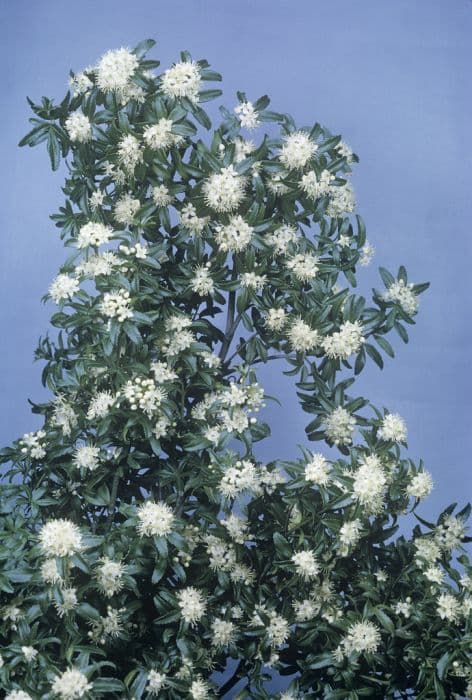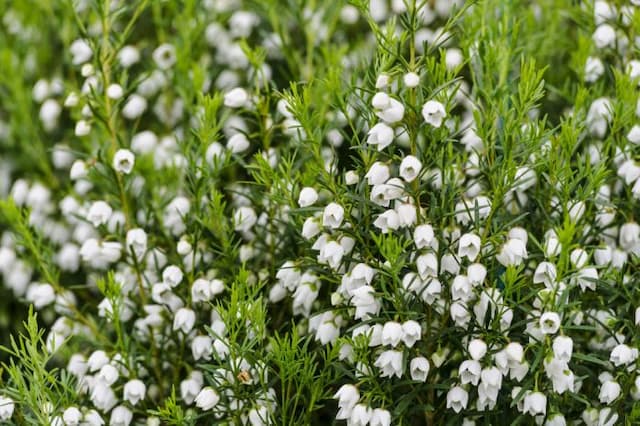Japanese Skimmia Skimmia japonica 'Bronze Knight' (m)

ABOUT
Skimmia japonica 'Bronze Knight', commonly referred to as Japanese skimmia, is a male cultivar renowned for its handsome foliage and fragrant flowers. This evergreen shrub features leathery, lance-shaped leaves with a rich green hue. The 'Bronze Knight' variant distinguishes itself with new foliage that emerges with a striking bronze tint before gradually maturing to green, creating a captivating display of color. As spring approaches, Japanese skimmia 'Bronze Knight' becomes adorned with dense clusters of small, aromatic flowers. These blooms are typically white or creamy in color, and although this male form does not produce berries, its flowers are noteworthy for their ability to produce abundant pollen. The plant's overall form is rounded and bushy, presenting a lush and textured appearance in the landscape. The glossy evergreen leaves coupled with the fragrant flowers make this plant an attractive addition to gardens, providing year-round visual interest and a delightful scent during the blooming season.
About this plant
 Names
NamesFamily
Rutaceae
Synonyms
Japanese Skimmia, Bronze Knight Skimmia
Common names
Skimmia japonica 'Bronze Knight' (m).
 Toxicity
ToxicityTo humans
Skimmia is considered to have a degree of toxicity to humans. If ingested, the plant can cause symptoms such as vomiting, diarrhea, and abdominal pain. It is worth noting that the berries of Skimmia can be particularly attractive to children but should be avoided due to their toxic properties. Handling the plant can sometimes result in skin irritation or an allergic reaction, although this is less common. It's important to seek medical attention if ingestion is suspected.
To pets
Skimmia is also toxic to pets. Animals that ingest parts of the plant may experience symptoms such as vomiting, diarrhea, and abdominal pain. The berries can be especially appealing to pets but are equally poisonous. In severe cases, ingestion can lead to more serious symptoms, including weakness, reduced heart rate, and collapse. Pet owners should be vigilant and prevent their pets from ingesting any part of the plant, and should consult a veterinarian immediately if ingestion is suspected.
 Characteristics
CharacteristicsLife cycle
Perennials
Foliage type
Evergreen
Color of leaves
Green
Height
3-4 feet (0.9-1.2 meters)
Spread
3-4 feet (0.9-1.2 meters)
Plant type
Shrub
Hardiness zones
7
Native area
Japan
Benefits
 General Benefits
General Benefits- Ornamental Appeal: Skimmia japonica 'Bronze Knight' features attractive, evergreen foliage with bronze-tinted new growth that adds year-round interest to gardens.
- Easy to Grow: It is a low-maintenance plant, ideal for gardeners who prefer plants that don't require constant attention.
- Shade Tolerance: This variety of Skimmia thrives in partial to full shade, making it suitable for planting under trees or in shaded areas of the garden where many plants won't grow.
- Drought Resistance: Once established, it is relatively drought tolerant, reducing the need for frequent watering.
- Pest Resistance: Generally resistant to most common pests, minimizing the need for chemical treatments.
- Deer Resistance: It is not a preferred choice for deer, which can help prevent damage in areas where deer browsing is a problem.
- Winter Interest: With its evergreen leaves and often red berries, it provides color and texture to the winter garden.
- Wildlife Support: Produces flowers that are attractive to pollinators, such as bees, and the berries can provide food for birds during winter months.
- Compact Growth: With its compact size, Skimmia japonica 'Bronze Knight' is suitable for small gardens or use in mixed borders without overwhelming the space.
- Cultural Significance: Skimmia has been used in gardening for many years, and its subtle beauty complements a variety of landscape styles and design approaches.
 Medical Properties
Medical PropertiesThis plant is not used for medical purposes.
 Air-purifying Qualities
Air-purifying QualitiesThis plant is not specifically known for air purifying qualities.
 Other Uses
Other Uses- Skimmia japonica 'Bronze Knight' can be used as a natural dye, providing a range of colors from its leaves and berries in traditional textile dyeing processes.
- Intriguingly, crushed leaves of Skimmia can emit a strong scent that may serve as a natural repellent to certain pests and animals when spread around a garden.
- Landscape artists sometimes incorporate Skimmia branches into natural sculptures or living art pieces due to their aesthetic foliage and structure.
- The dense foliage of Skimmia can be used in creating privacy screens or natural barriers in small gardens or balcony spaces.
- During festive seasons, Skimmia branches can be trimmed and added to flower arrangements or wreaths for natural greenery with a unique texture.
- Photographers and filmmakers may use Skimmia in set design to create an authentic woodland scene or as a durable, long-lasting green filler.
- Bonsai enthusiasts sometimes use Skimmia as a subject due to its slow growth and the potential for training into miniature tree forms.
- The strong structure of Skimmia can be included in outdoor model landscapes or train dioramas, providing a realistic representation of vegetation.
- Skimmia berries can be used as a natural colorant for crafting eco-friendly inks and paints for art projects.
- The plant's vibrant seasonal changes make it excellent for educational purposes, demonstrating the life cycle of plants to students and nature enthusiasts.
Interesting Facts
 Feng Shui
Feng ShuiSkimmia is not used in Feng Shui practice.
 Zodiac Sign Compitability
Zodiac Sign CompitabilitySkimmia is not used in astrology practice.
 Plant Symbolism
Plant Symbolism- Protection – Skimmia japonica, often simply referred to as Skimmia, is believed to symbolize protection due to its robust nature and evergreen leaves, suggesting endurance and a shield against external forces.
- Peace – The aromatic and dense foliage of the Skimmia plant can be indicative of tranquility and calmness, making it a common symbol of peace and serene environments.
- Balance – Skimmia 'Bronze Knight' possesses a natural symmetry and balance in its growth habit and foliage color, representing harmony and equilibrium in life.
- Perseverance – With its ability to thrive in various conditions and maintain its foliage throughout the seasons, Skimmia can symbolize the perseverance needed to navigate life's challenges.
- Renewal – The 'Bronze Knight' variety, with its bronze-colored new growth that transitions to green, signifies renewal and the idea of new beginnings or fresh starts.
 Water
WaterJapanese Skimmia 'Bronze Knight' prefers consistently moist soil, so it's important to water it deeply when the top inch of soil becomes dry. This may require watering once or twice a week, depending on the climate and the season. Aim to provide about 1 to 1.5 gallons of water every week during the growing season. In the winter, when the plant is not actively growing, reduce the frequency but ensure the soil doesn't completely dry out. Always use a gentle flow of water to avoid disturbing the soil or damaging the plant.
 Light
LightJapanese Skimmia 'Bronze Knight' thrives in partial shade, though it can tolerate full shade as well. The best spot for this plant is one where it receives filtered sunlight or a few hours of morning sun followed by shade in the afternoon. Avoid placing it in full sun, as the leaves can become scorched and lose their vibrant color.
 Temperature
TemperatureJapanese Skimmia 'Bronze Knight' is a hardy plant that prefers cooler temperatures, typically ranging from 60 to 75 degrees Fahrenheit. It can withstand minimum temperatures down to about 10 degrees Fahrenheit, but frost and freezing temperatures can damage the foliage and flowers. For optimal growth, protect it from harsh winter winds and place it in a location where it can enjoy consistent, cool temperatures.
 Pruning
PruningPruning Japanese Skimmia 'Bronze Knight' is mainly for shaping and removing any damaged or diseased branches. It's best to prune in early spring before new growth starts or right after it has finished flowering. This plant doesn't require heavy pruning, and over-pruning can reduce its natural beauty and flowering potential, so only prune as necessary.
 Cleaning
CleaningAs needed
 Soil
SoilJapanese Skimmia 'Bronze Knight' thrives in well-draining, rich, acidic soil with a pH between 5.5 and 6.5. The best soil mix should contain peat moss, pine bark, and perlite to ensure proper drainage and retain suitable acidity. Organic matter such as compost can be added to enrich the soil.
 Repotting
RepottingJapanese Skimmia 'Bronze Knight' should be repotted every 2-3 years to ensure it has enough room for root growth and to replenish the nutrients in the soil. Repotting is best done in late winter or early spring before new growth starts.
 Humidity & Misting
Humidity & MistingJapanese Skimmia 'Bronze Knight' prefers moderate to high humidity levels. It thrives best in an environment where humidity is kept consistently above 50%, which mimics its natural forest habitat.
 Suitable locations
Suitable locationsIndoor
Place in bright, indirect light with cool temperatures.
Outdoor
Plant in partial shade, shelter from harsh sun.
Hardiness zone
6-8 USDA
 Life cycle
Life cycleThe life cycle of Skimmia japonica 'Bronze Knight,' commonly known as Japanese Skimmia, begins with seed germination, which is relatively slow and may require a period of cold stratification to break dormancy. Upon germination, the seedling develops a root system and foliage in the form of juvenile leaves. As the plant matures, it enters a vegetative stage, characterized by the growth of glossy, evergreen leaves and sturdy stems. Japanese Skimmia 'Bronze Knight' typically takes a few years to reach flowering maturity, where it produces dense panicles of fragrant white blooms, though as a male cultivar, it bears no fruit but can provide pollen for female plants. Following the flowering season, the plant enters a period of growth where it continues to expand in size and foliage density. The plant's life cycle is perennial, so it will return to the flowering stage annually, continuing this cycle for many years, often with minimal care once established.
 Propogation
PropogationPropogation time
Late winter to early spring
Skimmia japonica 'Bronze Knight', commonly known as Japanese skimmia, is typically propagated by semi-ripe cuttings. The ideal time for taking these cuttings is during the late summer to early fall. To propagate, one should select healthy, semi-ripe stems that have begun to harden but are still somewhat flexible. The cuttings should be about 4 to 6 inches (10 to 15 cm) long and the lower leaves should be removed. The base of the cutting is then dipped in rooting hormone to encourage root development. After that, the cuttings are placed in a well-draining potting mix and kept in a humid, shaded environment until roots have formed, which may take several months. During this period, it is crucial to maintain consistent moisture levels without saturating the soil to prevent rot.


![Mexican orange [Sundance]](/_next/image?url=https%3A%2F%2Fplants-admin.emdemapps.com%2Fimages%2Fplants%2F%2Fimages%2F604b5381bcf0d.png&w=640&q=75)






